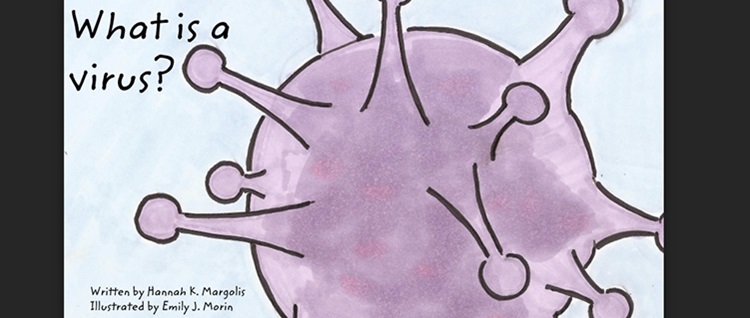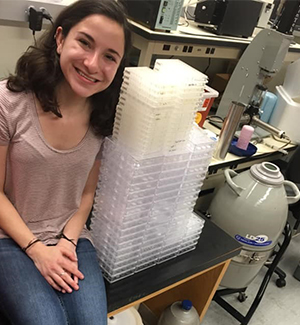
A new and free book, What Is a Virus?, tackles virus sizes, varieties, and more. (Copyright 2020 Hannah Margolis)
Sigma Xi member Hannah Margolis wrote a book, What Is a Virus?, to help children and parents learn the basics of viruses as we all face SARS-CoV-2, the virus that causes COVID-19. The book is available for free online and was illustrated by her friend and fellow recent Darmouth College graduate Emily Morin. Margolis studied biochemistry and global health at Dartmouth and currently works at the National Institutes of Health. She shared with Sigma Xi her hopes for the book, and its reception so far.
Heather Thorstensen: Why did you start working on the book?

Hannah Margolis: With the shutdown of schools I became incredibly frustrated that all over the country, younger students were suddenly having to study at home and didn't completely understand why. I also know that many parents probably haven't learned about viruses since high school biology so it might be difficult for them to answer questions properly that their kids might be having about what is going on and how to stay safe. This was coupled with the fact that all of the sudden there was a huge public interest in viruses and also a lot of misunderstandings and confusion: people didn't understand how this virus could be different than those causing the flu or cold in terms of infectivity, symptoms, incubation period before you know you're sick, etc.
I personally think that a lot of science and academia has failed the public in making science accessible and it really bugs me. Now all of the sudden there were people actually coming to scientists or the scientific community asking to be informed and I think we really need to take advantage of that.
As a side note that might illustrate what I'm getting at better if this doesn't make sense, Carl Sagan is one of my absolute scientific heroes and writers. In one of his books he tells this short anecdote of a cab driver who realized he was Carl Sagan and asked if he could ask some science questions. Of course Sagan was thrilled, but the cab driver proceeded to ask about healing crystals, alien life, Atlantis, etc. Sagan noted that the guy was really informed and really curious—he was wide-read about these fake phenomena. But he notes how the scientific community and school systems had failed him—he didn't know how to sort out the truth from fiction. In Sagan's words "this man wanted to learn about science, but all of the science had been filtered out before it reached him." This was one of those opportunities to get the science through in its more pure and simple form because people were suddenly open and receptive to hearing it.
My other goal in writing the book was to make it completely honest. I didn't want to anthropomorphize viruses or use too many analogies. I wanted to explain in very simple terms the basics of what viruses are in scientific terms to remove the mystery around them (they aren't alive, they aren't trying to make you sick, becoming sick is a side effect of viral replication, etc). No one should be made to feel stupid if they have basic questions about viruses, how they make us sick, or how to stay safe. It's so easy nowadays to become misinformed or pick up only part of the true information. So I wanted to explain everything from the ground up, but also include side bars with more advanced and related information for people who were interested in going a bit beyond the basics, hearing about the quirks of other scientists, learning how we know what we know, etc.
HT: Have you had any feedback so far that made you think the book is helping people?
HM: Yes, some! I’ve mostly had success spreading the book through Dartmouth platforms and in my hometown in northeastern Nevada. The first positive feedback I got was from a Dartmouth alum who read the book to her four-year-old daughter. Apparently her daughter really enjoyed it and the mom said she learned some things, too. That was my biggest hope for the book—that it can be informative and interesting for everyone, regardless of age or background. I know that in writing many of the sidebars, I learned new things, too.
HT: Who do you see as the target audience for the book? What age group is most appropriate?
HM: I wrote the book specifically for kids and their parents, but I don’t think it has an overly narrow audience-range. I’ve had parents with four-year-olds though third or fourth graders indicate their kids enjoyed it. The purpose of including the sidebars especially was for there to be something for older kids or parents, too.
HT: What does your job entail now at the National Institutes of Health?
HM: I work as a postbac researcher in the Mizuno Lab. The lab studies the protein machinery that allows cells to adhere to surfaces, which is involved in things like wound healing, forming tissues, cell migration (for instance, immune cell movement), and cancer metastasis. We specifically use cryo-electron microscopy to see what these proteins look like on the molecular level and this technique is also used for discovering the structure of many viruses like SARS-CoV-2. Proteins are smaller than a wavelength of light, so we have to use techniques with x-rays or electrons to see them. It makes it more challenging, but also more rewarding to finally see what they look like and how they work to allow us to live and function.
Pictured above: Hannah Margolis
Heather Thorstensen is the manager of communications at Sigma Xi, The Scientific Research Honor Society.